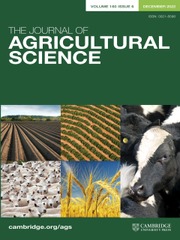Article contents
An approach to modelling the effect of environmental and physiological factors upon biomass accumulation in winter wheat
Published online by Cambridge University Press: 16 July 2001
Abstract
Six sites of variable soil type and environments in England and Scotland were sown with winter wheat (Triticum aestivum L. cv. Mercia) in the autumns of 1992 and 1993 with optimum inputs for growth. Crop monitoring between February and grain maturity provided data to investigate environmental and physiological factors important in controlling biomass accumulation.
With increasing use of crop modelling as a tool for interpreting experiments and as crop management decision support systems, it is important that all influences on crop productivity are understood. The ‘radiation use efficiency’ or radiation conversion coefficient provides a convenient basis to study these influences.
Significant differences in seasonal radiation conversion coefficients were observed between sites (P < 0·001), ranging from 2·82 to 3·87 g total dry matter/MJ absorbed photosynthetically active radiation. A series of simple dry matter models were developed to help explain biomass accumulation in relation to a number of environmental variables (using the measured green area index as an input) with correlation coefficients [ges ] 0·98 obtained across all sites. Apart from sunlight, differences in the canopy's ability to accumulate nitrogen and maintenance respiration costs were the most significant factors (P < 0·001). The nitrogen effect suggests changes in the conversion of assimilates with nitrogen availability, despite relatively high nutrition levels ([ges ] 180 kg N/ha).
Over all sites the canopy extinction coefficient could be described as a linear function of the site spring time plant population (P < 0·01). A more detailed model considered canopy light attenuation to vary between sites according to sowing date and autumn/winter plant establishment and environment.
Information
- Type
- Research Article
- Information
- Copyright
- © 2001 Cambridge University Press
- 6
- Cited by

